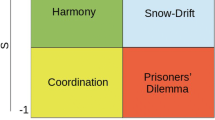Abstract
The game of tag is frequently used in the study of pursuit and evasion strategies that are discovered through competitive coevolution. The aim of coevolution is to create an arms race where opposing populations cyclically evolve in incremental improvements, driving the system towards better strategies. A coevolutionary simulation of the game of tag involving two populations of agents; pursuers and evaders, is developed to investigate the effects of a boundary and two obstacles. The evolution of strategies through Chemical Genetic Programming optimizes the mapping of genotypic strings to phenotypic trees. Four experiments were conducted, distinguished by speed differentials and environmental conditions. Designing experiments to evaluate the efficacy of emergent strategies often reveal necessary steps needed for coevolutionary progress. The experiments that excluded obstacles and boundaries provided design pointers to ensure coevolutionary progress as well as a deeper understanding of strategies that emerged when obstacles and boundaries were added. In the latter, we found that an awareness of the environment and the pursuer was not critical in an evader’s strategy to survive, instead heading to the edge of the boundary or behind an obstacle in a bid to ‘throw-off or hide from the pursuer’ or simply turn in circles was often sufficient, thereby revealing possible suboptimal strategies that were environment specific. We also observed that a condition for coevolutionary progress was that the problem complexity must be surmountable by at least one population; that is, some pursuer must be able to tag an opponent. Due to the use of amino-acid building blocks in our Chemical Genetic Program, our simulations were able to achieve significant complexity in a short period of time.


























Similar content being viewed by others
Notes
We use the term ‘simultaneous’ in the game theoretic sense that neither pursuer nor evader have any prior or present knowledge of what was and will be each other’s next strategy.
References
Miller, G., Cliff, D.: Co-evolution of pursuit and evasion I: biological and game-theoretic foundations. Technical Report CSRP311, School of Cognitive and Computing Sciences, University of Sussex, Brighton, UK (1994). Available at http://www.macalester.edu/∼fox/cs88/papers/csrp311.ps
Smith, R.E., Dike, B.A.: An application of genetic algorithm to air combat maneuvering. In: Handbook of Evolutionary Computation, published in cooperation with the Institute of Physics, Ringbound edition, 17 April 1997
Reynolds, C.W.: Competition, coevolution and the game of tag. In: Brooks, R., Maes, P. (eds.) Proceedings of the Artificial Life IV, pp. 59–69. MIT Press, Cambridge, MA (1994)
Weigand, R.P.: An analysis of coevolutionary algorithms. Dissertation submitted in partial fulfillment of the requirements for the degree of Doctor of Philosophy, George Mason Uni., (2003). Available at http://www.tesseract.org/paul/dissertation.html
Ficici, S.G., Pollack, J.B.: Challenges in coevolutionary learning: arms-race dynamics, open-endedness, and mediocre stable states. In: Adami, C., et al. (eds.) Proceedings of the Sixth Conference on Artificial Life, pp. 238–247. MIT Press (1998)
de Jong, E.D., Pollack, J.B.: Learning the ideal evaluation function. In: Cantu-Paz, E., et al. (eds.) Proceedings of the Genetic and Evolutionary Computation Conference, GECCO-03, pp. 274–285. Springer Verlag, Berlin (2003)
Piaseczny, W., Suzuki, H., Sawai, H.: Chemical Genetic Programming – coevolution between genotypic strings and phenotypic trees. In: Proceedings of the Genetic and Evolutionary Computation-GECCO, vol. 2, pp. 715–717 (2004)
Piaseczny, W., Suzuki, H., Sawai, H.: Chemical Genetic Programming – the effect of evolving amino acids. In: Keijzer, M. (ed.) Late Breaking Papers at the 2004 Genetic and Evolutionary Computation Conference, Seattle, Washington, USA (2004)
Piaseczny, W., Suzuki, H., Sawai, H.: Chemical Genetic Programming – evolution of amino acid rewriting rules used for genotype-phenotype translation. In: Proceedings of the IEEE Congress on Evolutionary Computation, pp. 1639–1645 (2004)
Chan, C.S., Tay, J.C., Sawai, H.: Discovering pursuit and evasion strategies for a bounded environment with two obstacles. In: Proceedings of the Third International Conference for Computational Intelligence, Robotics and Autonomous Systems (CIRAS 2005), Singapore, 13–16th December, 2005
O’Neill, M., Ryan, C.: Grammatical evolution. In: IEEE Transactions on Evolutionary Computation, vol. 5(4), August (2001)
Juille, H., Pollack, J.B.: Coevolving the "ideal" trainer: application to the discovery of cellular automata rules. In: Koza, J.R., et al. (eds.) Proceedings of the Third Annual Conference on Genetic Programming, pp. 519–527. Morgan Kaufmann (1998)
Sims, K.: Evolving 3D morphology and behavior by competition. In: Brooks, R., Maes, P. (eds.) Proceedings of the Artificial Life IV, pp. 28–39. MIT Press (1994)
Suzuki, H., Sawai, H.: Chemical genetic algorithms -evolutionary optimization of code translation. In: Proceedings of the Eighth International Symposium on Artificial Life and Robotics (AROB 8th ’03), vol. 1, pp. 172–175 (2003)
Cliff, D., Miller, G.F.: Tracking the Red Queen: measurements of adaptive progress in co-evolutionary simulations. In: Advances in Artificial Life: Proceedings of the Third European Conference on Artificial Life, pp. 200–218. Springer-Verlag (1995)
Mitchell, M.: An Introduction to Genetic Algorithms. MIT Press, Cambridge, MA (1996)
Author information
Authors and Affiliations
Corresponding author
Rights and permissions
About this article
Cite this article
Tay, J.C., Tng, C.H. & Chan, C.S. Environmental effects on the coevolution of pursuit and evasion strategies. Genet Program Evolvable Mach 9, 5–37 (2008). https://doi.org/10.1007/s10710-007-9049-3
Received:
Revised:
Accepted:
Published:
Issue Date:
DOI: https://doi.org/10.1007/s10710-007-9049-3




